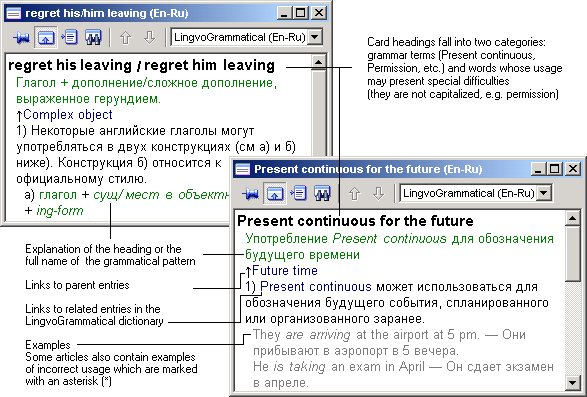Working with the Grammatical Dictionary
The LingvoGrammatical dictionary is a hyperlinked English grammar reference book. It has about 500 entries containing major grammatical patterns, rules and examples. The dictionary contains information on usage, differences between British and American English, pronunciation variants, etc. It also deals with some finer points of English grammar (e.g. it has cards for “give me this” and “give this to me”). The first (primary) entry in the dictionary is Grammar, which contains links to six major topics: Parts of Speech, Syntax, Speech situations, American and British English, Spelling, and Punctuation. The entries are organized in a hierarchical structure and you can go from a more general topic to a more specific topic or vice versa by clicking on the respective links. Some cards in the LingvoUniversal dictionary also have hyperlinks to the LingvoGrammatical dictionary.
Working with the LingvoGrammatical dictionary is similar to working with other Lingvo dictionaries, only you have to remember that instead of translations it offers articles dealing with various grammar issues, as well as rules and usage examples.
You can open the necessary cards from the LingvoGrammatical dictionary by clicking on the respective links on some cards from the LingvoUniversal dictionary or you can simply read the LingvoGrammatical dictionary as a hyperlinked grammar book.
Entry structure and conventions used in the dictionary

Example
Suppose you need to translate the following Russian sentence: Проходя мимо кухни, он остановился, чтобы выпить стакан воды. Do you say:
- Passing the kitchen, he stopped to drink a glass of water or
- Passing the kitchen, he stopped drinking a glass of water ?
Type ing-form in the Edit Line and perform a full-text search. Lingvo will find the following cards that will help you make the right choice:
Verb + to-infinitive or ing-form?
stop, go on + to-infinitive or ing-form
Once you have studied these cards, you will see that stop
can be followed by either a to-infinitive or an ing-form but with
different meanings: stop + ing-form means to finish an action in progress
and stop + to-infinitive means to interrupt an activity in order to do
something else (the infinitive of purpose). Therefore the correct translation
would be:
Passing the kitchen he stopped to drink a glass of water.